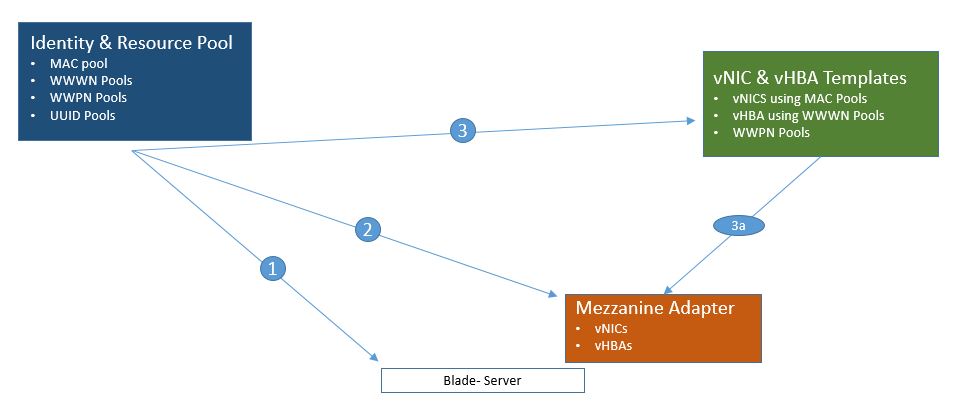EMAIL SUPPORT
dclessons@dclessons.comLOCATION
USIdentity & Resource Pool Overview
In the Cisco UCS platform, UCS servers don’t use or consume the hardware burned-in identities. However, all the unique characteristics are extracted from identity and resource pool, which resides on Fabric Interconnects and are managed by UCSM.
These identities are extracted from UCSM in form of Service Profile, which has all server identities like WWNN, WWPN, MAC, IP Pool, Firmware version, BIOS Setting, and other server setting. These poos are applied to Server, when a Service Profile, consuming these identities are attached to particular Server.
In case of Server failure, if failed server needs to be removed, the replacement server has to be associated to same Service Profile, of the failed server. The New Server will automatically pick up all the identities of the failed server and the operating system or applications dependent upon these identities will not observe any change in hardware.
In the UCSM, main organization unit is root and further sub-organization can be defined under this. The Identity pools, which are defined under one organization unit cannot be migrated to other organizational units unless they are deleted first and then created again where required.
Below figure shows ow identity and resource pools provide unique feature to a stateless blade server:

Stateless computing requires unique identity resources for universally unique identifiers (UUIDs), MAC addresses, and worldwide names (WWNs) for Fibre Channel.
Using pooled resources ensures consistent application of policy and reasonable assurances that identities are unique within the Cisco UCS Manager.
UUID Pools
UUIDs are designed as globally unique identifiers for each compute node on a network. UUIDs are used in a number of different ways. In the context of Cisco UCS, the UUID refers to a 128- bit identifier coded into the compute node BIOS. Operating systems, hypervisors, and applications can leverage the UUID for processes like activation, internal disk labels, and so on.
Some applications may use the UUID as an internal root value propagated very tightly within data structures. Therefore, UUIDs should be locally administered in the service profile instead of derived from the BIOS. UUIDs within a service profile are mobile.
If the underlying compute node fails, the service profile carries the UUID to the replacement compute node, eliminating the need for potentially time-consuming search and- replace operations
UUID Format
- UUID are globally unique 128-it numbers. Many schemes exit to define or generate the UUID
- Cisco UCS manager uses a configurable 64-bit prefix and allow you to specify a range of suffix for use by compute node.
- It is recommended that prefix be set to the same 24-bit OUI as used in WWN pools
We will see how to crate UUID Polls in Lab sections
MAC Pools
A MAC pool consists of one or more ranges of MAC addresses. You can create the MAC pool and assign a name. With MAC pools, Cisco UCS administration is made easier when scaling server deployment of service profiles by prompting stakeholders to define a set of MAC addresses before actual deployment
WWNN Pool
It is a 64-bit address assigned to Fibre Channel FC Deices. WWNN is assigned to the Mezzanine cards installed in a blade server, which has more than one port (vHBA). Each Port (vHBA) created from Mezzanine card acquires a unique WWPN.
WWNs are 64-bit addresses that have many possible format, as Cisco UCS Manager enforces a specific format in all WWN pools.





LEAVE A COMMENT
Please login here to comment.